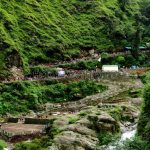Traditionally, Char Dham was done on the foot to seek the penance of the deities for all the worldly sins committed by oneself. With the technology and better road connectivity, now Char Dham is not only pilgrimage but also an adventure travel. The adventure seekers prefer to travel by their bikes or cars to amalgamate the adventure with seeking penance.
From pilgrimage point of view this tour should begin from the West and end in the East. Thus, the Char Dham Yatra commences from Yamunotri, then proceeding to Gangotri and finally to Kedarnath and Badrinath. In accordance with the Hindu conventions, thousands of devotees take up this pious tour in the hope to experience bliss and successfully purge their souls of all worldly demons.
Kedarnath is the most remote of the four Char Dham sites and is flanked by breathtaking snow-clad peaks. Known for the ancient Shiva Temple, a trip to Kedarnath is an exhilarating experience. Like the other sites, Kedarnath closes on the first day of the Hindu month of Kartik (October-November) and reopens in Vaishakh (April-May) every year.
According to legend, the Pandavas after having won over the Kauravas in the Kurukshetra war, felt guilty of having killed their own Kith and Kin and sought blessings of Lord Shiva for redemption. He eluded them repeatedly and while fleeing took refuge at Kedarnath in the form of a bafellow.
On being followed, the Lord dived into the ground, leaving his hump on the surface at Kedarnath. The remaining portions of Lord Shiva appeared at four other places and are worshipped there as his manifestations. The arms of the Lord appeared at Tungnath, the face at Rudranath, the belly at Madmaheshwar and his locks (hair) with head at Kalpeshwar. The Kedarnath and four above mentioned shrines are treated as Panch Kedar (Panch means Five in Sanskrit).
The Temple at Kedarnath presents an imposing sight, standing in middle of a wide plateau surrounded by lofty snow covered peaks. The temple was originally built in 8th century A.D. by Jagad Guru Adi Shankaracharya and stands adjacent to site of an even earlier temple built by the Pandavas. The inner walls of the assembly hall are decorated with figures of various deities and scenes from mythology. Outside the temple door a large statue of the Nandi Bafellow stands as guard.
Dedicated to Lord Shiva, the Kedarnath temple has exquisite architecture Built of extremely large, heavy and evenly cut grey slabs of stones, it evokes wonder as to how these heavy slabs were moved and handled in the earlier centuries. The temple has a Garbha Griha for worship and a Mandap, apt for assemblies of pilgrims and visitors. A conical rock formation inside the temple is worshipped as Lord Shiva in his Sadashiva form.










